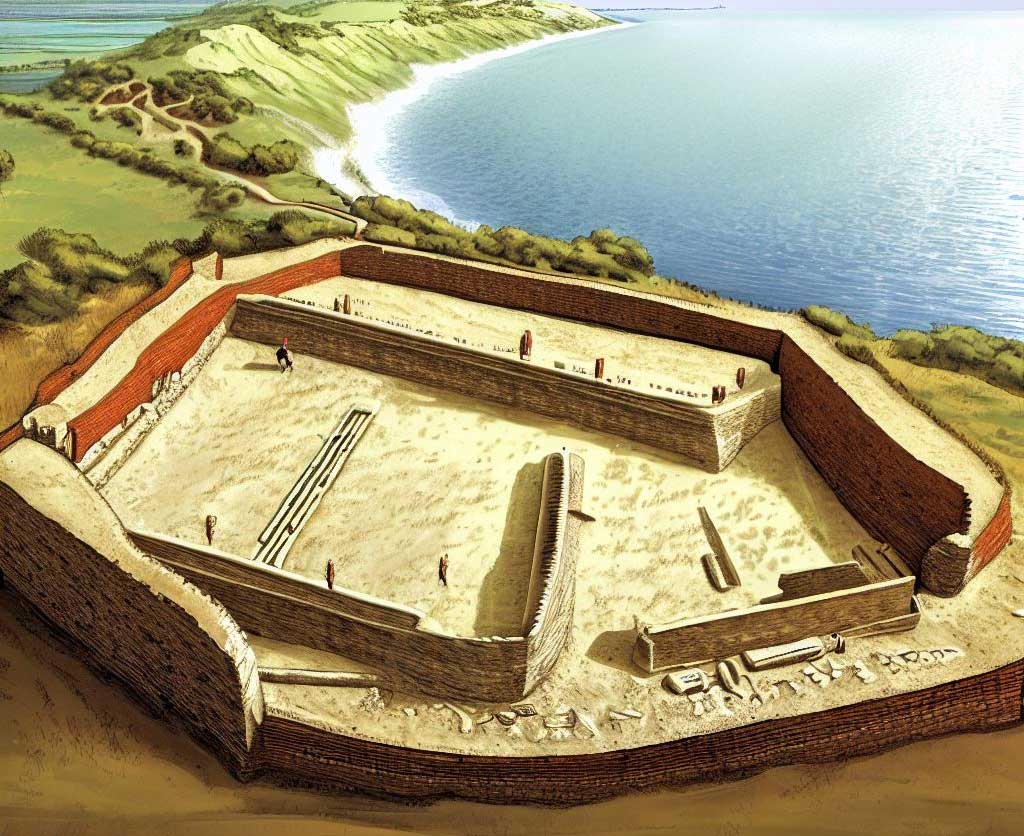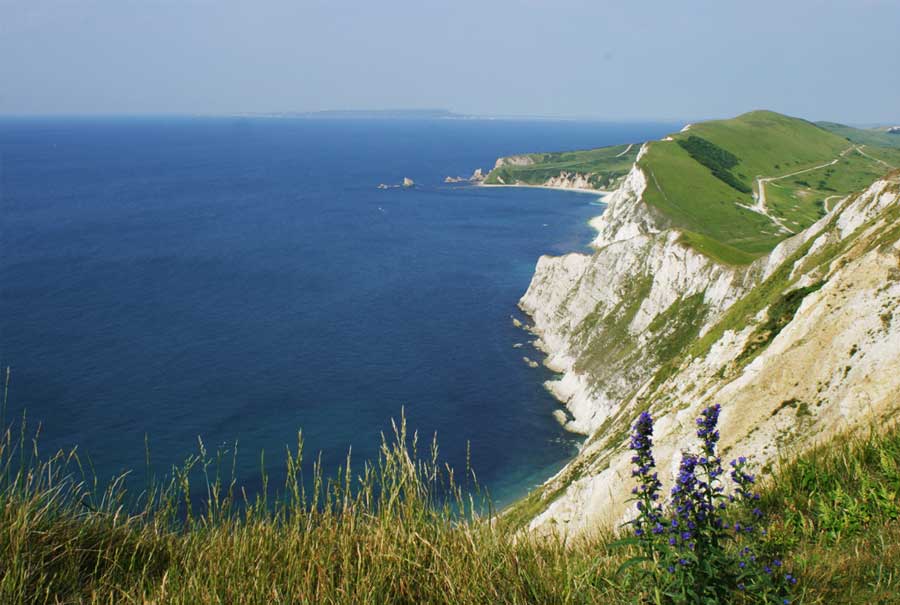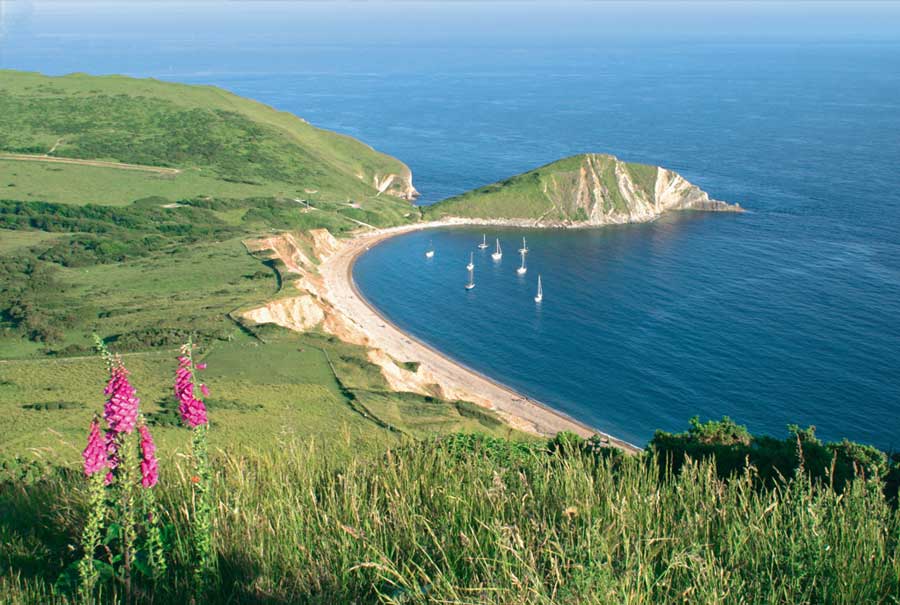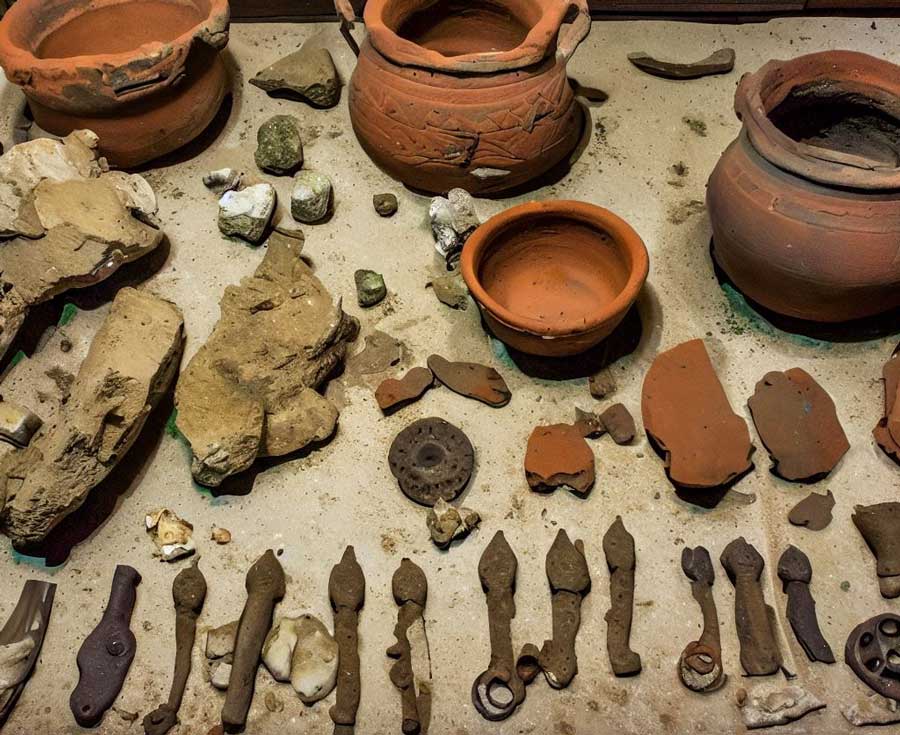Flower’s Barrow, a hidden gem nestled along the enchanting Dorset coast, carries a profound historical significance that spans thousands of years.
From its origins as an Iron Age hillfort, perched majestically overlooking the stunning Chesil Beach in the distance, to its role in the Roman era as a strategic outpost, this site has witnessed the rise and fall of civilizations. It’s a place where the echoes of our ancestors resonate in the earthworks and the stones.
Location of Flower’s Barrow in Dorset
From Tyneham Village, follow the well-marked footpaths that lead southwest toward Flowers Barrow. The walk is both scenic and informative, offering glimpses of the lush Dorset countryside and the coastal beauty of the English Channel.
As you traverse the footpaths, keep an eye out for signposts that guide you towards Flower’s Barrow. The walk typically takes about 30 to 40 minutes, and you’ll be rewarded with breathtaking views of Chesil Beach and Worbarrow Bay, and the opportunity to delve into the rich history of Flowers Barrow.
The Walk from Tyneham Village to Flower’s Barrow
Ancient Origins: A Fortified Past
The story of Flowers Barrow begins in the Iron Age, around 2,500 years ago. At that time, this prominent headland served as the location for a formidable hillfort. Iron Age hillforts were defensive structures, often built on high vantage points, and Flowers Barrow was no exception. Its strategic location provided a commanding view of the surrounding landscape, making it an ideal spot for early inhabitants to protect themselves from potential invaders.
The fortifications at Flower’s Barrow consisted of earthen banks and ditches, accompanied by timber and stone walls. These defences, combined with the natural cliffs on the seaside, formed a formidable barrier. Inside the hillfort, an Iron Age community would have lived, farmed, and conducted trade.
One of the most remarkable aspects of Flowers Barrow is its labyrinthine design. It features multiple concentric rings of earthworks and defensive walls, suggesting that it underwent several phases of construction and expansion during its Iron Age occupation. The intricate layout is a testament to the skill and craftsmanship of its ancient builders.

Roman Conquest: A Bridge Between Eras
As we delve deeper into the history of Flowers Barrow, we encounter the Roman influence that swept through Britain during the 1st century AD. The Romans recognized the strategic importance of the Dorset coast, and they established their presence in the area, including Flowers Barrow.
During the Roman period, Flowers Barrow underwent significant changes. The original Iron Age fortifications were modified and integrated into the broader Roman defensive system. The Romans constructed a large fort within the hillfort’s boundaries, showcasing their engineering prowess and organizational skills.
This Roman fort served a crucial role in controlling the nearby harbour and trade routes along the coast. Its strategic importance was further underscored by the construction of a Roman road that connected it to the nearby town of Dorchester (Durnovaria), which was a thriving Roman settlement.
Visitors to Flower’s Barrow today can still discern the layout of Roman structures within the hillfort, including remnants of buildings, walls, and defensive features. These archaeological traces provide valuable insights into the daily lives of the Roman garrison stationed here and their interactions with the local population.

Abandonment and Mystery: The Decline of Flowers Barrow
The Roman era at Flowers Barrow came to an end, but the hillfort’s story did not. Sometime in the 4th century AD, the Roman fortifications were abandoned, marking a shift in the site’s history. The exact reasons behind this desertion remain a mystery, with theories ranging from economic decline to political instability.
After this abandonment, Flowers Barrow quietly slipped into obscurity. The Iron Age and Roman structures slowly succumbed to the relentless forces of nature and time. The winds and waves of the English Channel battered the once-proud fortifications, and vegetation began to reclaim the land.
Rediscovery and Excavation: A Glimpse into the Past
Flowers Barrow might have faded from memory entirely if not for the efforts of modern archaeologists. In the 20th century, the site underwent extensive excavations, shedding light on its fascinating history.
One of the most significant discoveries was the identification of several coin hoards, indicating that Flowers Barrow was still a place of economic activity during the later Roman period. These coins provide valuable clues about the site’s role as a trading hub.
Additionally, archaeologists unearthed pottery, tools, and other artefacts that offer insights into the daily lives of the people who once called Flowers Barrow home. The remnants of Roman buildings, including a possible bathhouse, further highlight the complexity of the site.
Visiting Flowers Barrow Today: A Journey Through Time
Today, Flowers Barrow stands as a compelling testament to the layers of history that have shaped the Dorset coast. Visitors are treated to a unique blend of natural beauty and archaeological intrigue.
The site is managed by English Heritage, ensuring its preservation for future generations. When you arrive at Flowers Barrow, you’ll be greeted by sweeping views of Chesil Beach and the English Channel, providing a breathtaking backdrop to your historical exploration.
As you walk along the paths within the hillfort, you can trace the earthworks and defensive walls that have endured for millennia. Imagine the lives of Iron Age and Roman inhabitants who once lived within these fortifications, safeguarding their community against external threats.
Take a moment to sit atop the hill and gaze out at the same horizon that has captivated countless souls throughout history. The windswept grasses and panoramic views evoke a profound sense of connection to the past.

Preservation and Conservation: Protecting Flowers Barrow
The preservation of Flower’s Barrow is of utmost importance to ensure that its history endures for generations to come. The exposed location of the site, with its proximity to the sea, makes it vulnerable to erosion and weathering.
Efforts to protect the site include ongoing monitoring, stabilization of the earthworks, and public education about the significance of the hillfort. Visitors are encouraged to tread lightly, respecting the fragile archaeological remains and the natural environment that surrounds them.
Flower’s Barrow, with its enigmatic past and breathtaking coastal setting, is a treasure trove of history waiting to be discovered. It has witnessed the rise and fall of civilizations, the ebb and flow of tides, and the passage of time.
It is a testament to the enduring human spirit, a place where history, nature, and the human imagination converge. It beckons us to explore, to reflect, and to appreciate the rich tapestry of stories that have unfolded on this windswept headland. It invites us to become a part of its timeless legacy.
So, if you find yourself visiting Tyneham or Worbbarow Bay, don’t miss the opportunity to visit Flowers Barrow. Take a step back in time, let the whispers of history surround you, and be captivated by the magic of this remarkable place.

